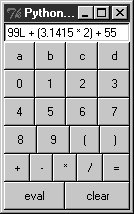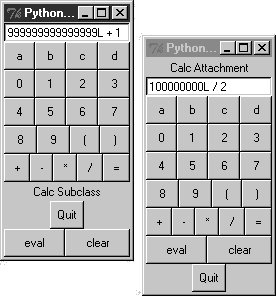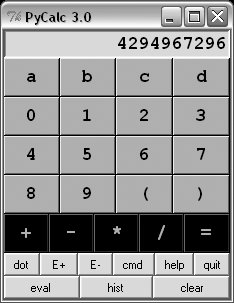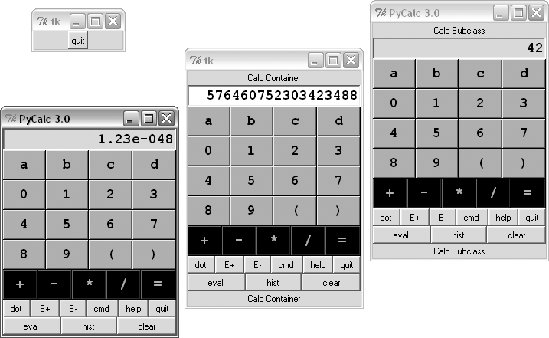Section 21.7. PyCalc: A Calculator ProgramObject
21.7. PyCalc: A Calculator Program/ObjectTo wrap up this chapter, I'm going to show you a practical application for some of the parsing technology introduced in the preceding section. This section presents PyCalc, a Python calculator program with a graphical interface similar to the calculator programs available on most window systems. But like most of the GUI examples in this book, PyCalc offers a few advantages over existing calculators. Because PyCalc is written in Python, it is both easily customized and widely portable across window platforms. And because it is implemented with classes, it is both a standalone program and a reusable object library. 21.7.1. A Simple Calculator GUIBefore I show you how to write a full-blown calculator, though, the module shown in Example 21-13 starts this discussion in simpler terms. It implements a limited calculator GUI, whose buttons just add text to the input field at the top in order to compose a Python expression string. Fetching and running the string all at once produces results. Figure 21-8 shows the window this module makes when run as a top-level script. Figure 21-8. The calc0 script in action on Windows (result=160.283) Example 21-13. PP3E\Lang\Calculator\calc0.py
21.7.1.1. Building the GUINow, this is about as simple as a calculator can be, but it demonstrates the basics. This window comes up with buttons for entry of numbers, variable names, and operators. It is built by attaching buttons to frames: each row of buttons is a nested Frame, and the GUI itself is a Frame subclass with an attached Entry and six embedded row frames (grids would work here too). The calculator's frame, entry field, and buttons are made expandable in the imported guitools utility module. This calculator builds up a string to pass to the Python interpreter all at once on "eval" button presses. Because you can type any Python expression or statement in the entry field, the buttons are really just a convenience. In fact, the entry field isn't much more than a command line. Try typing import sys, and then dir(sys) to display sys module attributes in the input field at the topit's not what you normally do with a calculator, but it is demonstrative nevertheless.[*]
In CalcGui's constructor, buttons are coded as lists of strings; each string represents a row and each character in the string represents a button. Lambdas are used to save extra callback data for each button. The callback functions retain the button's character and the linked text entry variable so that the character can be added to the end of the entry widget's current string on a press. Notice how we must pass in the loop variable as a default argument to some lambdas in this code. Recall from Chapter 8 how references within a lambda (or nested def) to names in an enclosing scope are evaluated when the nested function is called, not when it is created. When the generated function is called, enclosing scope references inside the lambda reflect their latest setting in the enclosing scope, which is not necessarily the values they held when the lambda expression ran. By contrast, defaults are evaluated at function creation time instead and so can remember the current values of loop variables. Without the defaults, each button would reflect the last iteration of the loop.
21.7.1.2. Running code stringsThis module implements a GUI calculator in 45 lines of code (counting comments and blank lines). But to be honest, it cheats: expression evaluation is delegated to Python. In fact, the built-in eval and exec tools do most of the work here:
Both accept optional dictionaries to be used as global and local namespaces for assigning and evaluating names used in the code strings. In the calculator, self.names becomes a symbol table for running calculator expressions. A related Python function, compile, can be used to precompile code strings to code objects before passing them to eval and exec (use it if you need to run the same string many times). By default, a code string's namespace defaults to the caller's namespaces. If we didn't pass in dictionaries here, the strings would run in the eval method's namespace. Since the method's local namespace goes away after the method call returns, there would be no way to retain names assigned in the string. Notice the use of nested exception handlers in the eval method:
Statements and invalid expressions might be parsed twice, but the overhead doesn't matter here, and you can't tell whether a string is an expression or a statement without parsing it manually. Note that the "eval" button evaluates expressions, but = sets Python variables by running an assignment statement. Variable names are combinations of the letter keys "abcd" (or any name typed directly). They are assigned and evaluated in a dictionary used to represent the calculator's namespace. 21.7.1.3. Extending and attachingClients that reuse this calculator are as simple as the calculator itself. Like most class-based Tkinter GUIs, this one can be extended in subclassesExample 21-14 customizes the simple calculator's constructor to add extra widgets. Example 21-14. PP3E\Lang\Calculator\calc0ext.py
It can also be embedded in a container classExample 21-15 attaches the simple calculator's widget package, along with extras, to a common parent. Example 21-15. PP3E\Lang\Calculator\calc0emb.py
Figure 21-9 shows the result of running both of these scripts from different command lines. Both have a distinct input field at the top. This works; but to see a more practical application of such reuse techniques, we need to make the underlying calculator more practical too. Figure 21-9. The calc0 script's object attached and extended 21.7.2. PyCalcA Real Calculator GUIOf course, real calculators don't usually work by building up expression strings and evaluating them all at once; that approach is really little more than a glorified Python command line. Traditionally, expressions are evaluated in piecemeal fashion as they are entered, and temporary results are displayed as soon as they are computed. Implementing this behavior requires a bit more work: expressions must be evaluated manually and in parts, instead of calling the eval function only once. But the end result is much more useful and intuitive.
This section presents the implementation of PyCalca Python/Tkinter program that implements such a traditional calculator GUI. It touches on the subject of text and languages in two ways: it parses and evaluates expressions, and it implements a kind of stack-based language to perform the evaluation. Although its evaluation logic is more complex than the simpler calculator shown earlier, it demonstrates advanced programming techniques and serves as an interesting finale for this chapter. 21.7.2.1. Running PyCalcAs usual, let's look at the GUI before the code. You can run PyCalc from the PyGadgets and PyDemos launcher bars at the top of the examples tree, or by directly running the file calculator.py listed shortly (e.g., click it in a file explorer). Figure 21-10 shows PyCalc's main window. By default, it shows operand buttons in black-on-blue (and opposite for operator buttons), but font and color options can be passed into the GUI class's constructor method. Of course, that means gray-on-gray in this book, so you'll have to run PyCalc yourself to see what I mean. Figure 21-10. PyCalc calculator at work on Windows If you do run this, you'll notice that PyCalc implements a normal calculator modelexpressions are evaluated as entered, not all at once at the end. That is, parts of an expression are computed and displayed as soon as operator precedence and manually typed parentheses allow. I'll explain how this evaluation works in a moment. PyCalc's CalcGui class builds the GUI interface as frames of buttons much like the simple calculator of the previous section, but PyCalc adds a host of new features. Among them are another row of action buttons, inherited methods from GuiMixin (presented in Chapter 11), a new "cmd" button that pops up nonmodal dialogs for entry of arbitrary Python code, and a recent calculations history pop up. Figure 21-11 captures some of PyCalc's pop-up windows. Figure 21-11. PyCalc calculator with some of its pop ups You may enter expressions in PyCalc by clicking buttons in the GUI, typing full expressions in command-line pop ups, or typing keys on your keyboard. PyCalc intercepts key press events and interprets them the same as corresponding button presses; typing + is like pressing the + button, the Space bar key is "clear," Enter is "eval," backspace erases a character, and ? is like pressing "help." The command-line pop-up windows are nonmodal (you can pop up as many as you like). They accept any Python codepress the Run button or your Enter key to evaluate text in the input field. The result of evaluating this code in the calculator's namespace dictionary is thrown up in the main window for use in larger expressions. You can use this as an escape mechanism to employ external tools in your calculations. For instance, you can import and use functions coded in Python or C within these pop ups. The current value in the main calculator window is stored in newly opened command-line pop ups too, for use in typed expressions. PyCalc supports long integers (unlimited precision), negatives, and floating-point numbers just because Python does. Individual operands and expressions are still evaluated with the eval built-in, which calls the Python parser/interpreter at runtime. Variable names can be assigned and referenced in the main window with the letter, =, and "eval" keys; they are assigned in the calculator's namespace dictionary (more complex variable names may be typed in command-line pop ups). Note the use of pi in the history window: PyCalc preimports names in the math and random modules into the namespace where expressions are evaluated. 21.7.2.2. Evaluating expressions with stacksNow that you have the general idea of what PyCalc does, I need to say a little bit about how it does what it does. Most of the changes in this version involve managing the expression display and evaluating expressions. PyCalc is structured as two classes:
As you can see from this, the magic of expression evaluation boils down to juggling the operator and operand stacks. In a sense, the calculator implements a little stack-based language, to evaluate the expressions being entered. While scanning expression strings from left to right as they are entered, operands are pushed along the way, but operators delimit operands and may trigger temporary results before they are pushed. Because it records states and performs transitions, some might use the term state machine to describe this calculator language implementation. Here's the general scenario:
In the end, the last value on the operands stack is displayed in the calculator's entry field, ready for use in another operation. This evaluation algorithm is probably best described by working through examples. Let's step through the entry of a few expressions and watch the evaluation stacks grow. PyCalc stack tracing is enabled with the debugme flag in the module; if true, the operator and operand stacks are displayed on stdout each time the Evaluator class is about to apply an operator and reduce (pop) the stacks. Run PyCalc with a console window to see the traces. A tuple holding the stack lists (operators, operands) is printed on each stack reduction; tops of stack are at the ends of the lists. For instance, here is the console output after typing and evaluating a simple string: 1) Entered keys: "5 * 3 + 4 <eval>" [result = 19] (['*'], ['5', '3']) [on '+' press: displays "15"] (['+'], ['15', '4']) [on 'eval' press: displays "19"] Note that the pending (stacked) * subexpression is evaluated when the + is pressed: * operators bind tighter than +, so the code is evaluated immediately before the + operator is pushed. When the + button is pressed, the entry field contains 3; we push 3 onto the operands stack, reduce the * subexpression (5 * 3), push its result onto operands, push + onto operators, and continue scanning user inputs. When "eval" is pressed at the end, 4 is pushed onto operators, and the final + on operators is applied to stacked operands. The text input field and expression stacks are integrated by the calculator class. In general, the text entry field always holds the prior operand when an operator button is pressed; the text in the entry field is pushed onto the operands stack before the operator is resolved. Because of this, we have to pop results before displaying them after "eval" or ) is pressed (otherwise the results are pushed onto the stack twicethey would be both on the stack and in the display field, from which they would be immediately pushed again when the next operator is input). When an operator is seen (or "eval" or ) is applied), we also have to take care to erase the entry field when the next operand's entry is started. Expression stacks also defer operations of lower precedence as the input is scanned. In the next trace, the pending + isn't evaluated when the * button is pressed: since * binds tighter, we need to postpone the + until the * can be evaluated. The * operator isn't popped until its right operand 4 has been seen. There are two operators to pop and apply to operand stack entries on the "eval" pressthe * at the top of operators is applied to the 3 and 4 at the top of operands, and then + is run on 5 and the 12 pushed for *: 2) "5 + 3 * 4 <eval>" [result = 17] (['+', '*'], ['5', '3', '4']) [on 'eval' press] (['+'], ['5', '12']) [displays "17"] For strings of same-precedence operators such as the following, we pop and evaluate immediately as we scan left to right, instead of postponing evaluation. This results in a left-associative evaluation, in the absence of parentheses: 5+3+4 is evaluated as ((5+3)+4). For + and * operations this is irrelevant because order doesn't matter: 3) "5 + 3 + 4 <eval>" [result = 12] (['+'], ['5', '3']) [on the second '+'] (['+'], ['8', '4']) [on 'eval'] The following trace is more complex. In this case, all the operators and operands are stacked (postponed) until we press the ) button at the end. To make parentheses work, ( is given a higher precedence than any operator and is pushed onto the operators stack to seal off lower stack reductions until the ) is seen. When the ) button is pressed, the parenthesized subexpression is popped and evaluated ((3 * 4), then (1 + 12)), and 13 is displayed in the entry field. On pressing "eval," the rest is evaluated ((3 * 13), (1 +39)), and the final result (40) is shown. This result in the entry field itself becomes the left operand of a future operator. 4) "1 + 3 * ( 1 + 3 * 4 ) <eval>" [result = 40] (['+', '*', '(', '+', '*'], ['1', '3', '1', '3', '4']) [on ')'] (['+', '*', '(', '+'], ['1', '3', '1', '12']) [displays "13"] (['+', '*'], ['1', '3', '13']) [on 'eval'] (['+'], ['1', '39']) In fact, any temporary result can be used again: if we keep pressing an operator button without typing new operands, it's reapplied to the result of the prior pressthe value in the entry field is pushed twice and applied to itself each time. Press * many times after entering 2 to see how this works (e.g., 2***). On the first *, it pushes 2 and the *. On the next *, it pushes 2 again from the entry field, pops and evaluates the stacked (2 * 2), pushes back and displays the result, and pushes the new *. And on each following *, it pushes the currently displayed result and evaluates again, computing successive squares. Figure 21-12 shows how the two stacks look at their highest level while scanning the expression in the prior example trace. On each reduction, the top operator is applied to the top two operands and the result is pushed back for the operator below. Because of the way the two stacks are used, the effect is similar to converting the expression to a string of the form +1*3(+1*34 and evaluating it right to left. In other cases, though, parts of the expression are evaluated and displayed as temporary results along the way, so it's not simply a string conversion process. Figure 21-12. Evaluation stacks: 1 + 3 * (1 + 3 * 4) Finally, the next example's string triggers an error. PyCalc is casual about error handling. Many errors are made impossible by the algorithm itself, but things such as unmatched parentheses still trip up the evaluator. Instead of trying to detect all possible error cases explicitly, a general TRy statement in the reduce method is used to catch them all: expression errors, numeric errors, undefined name errors, syntax errors, and so on. Operands and temporary results are always stacked as strings, and each operator is applied by calling eval. When an error occurs inside an expression, a result operand of *ERROR* is pushed, which makes all remaining operators fail in eval too. *ERROR* essentially percolates to the top of the expression. At the end, it's the last operand and is displayed in the text entry field to alert you of the mistake: 5) "1 + 3 * ( 1 + 3 * 4 <eval>" [result = *ERROR*] (['+', '*', '(', '+', '*'], ['1', '3', '1', '3', '4']) [on eval] (['+', '*', '(', '+'], ['1', '3', '1', '12']) (['+', '*', '('], ['1', '3', '13']) (['+', '*'], ['1', '*ERROR*']) (['+'], ['*ERROR*']) (['+'], ['*ERROR*', '*ERROR*']) Try tracing through these and other examples in the calculator's code to get a feel for the stack-based evaluation that occurs. Once you understand the general shift/reduce (push/pop) mechanism, expression evaluation is straightforward. 21.7.2.3. PyCalc source codeExample 21-16 contains the PyCalc source module that puts these ideas to work in the context of a GUI. It's a single-file implementation (not counting utilities imported and reused). Study the source for more details; as usual, there's no substitute for interacting with the program on your own to get a better feel for its functionality. Also see the opening comment's "to do" list for suggested areas for improvement. Like all software systems, this calculator is prone to evolve over time (and in fact it has, with each new edition of this book). Since it is written in Python, such future mutations will be easy to apply. Example 21-16. PP3E\Lang\Calculator\calculator.py
21.7.2.4. Using PyCalc as a componentPyCalc serves a standalone program on my desktop, but it's also useful in the context of other GUIs. Like most of the GUI classes in this book, PyCalc can be customized with subclass extensions or embedded in a larger GUI with attachments. The module in Example 21-17 demonstrates one way to reuse PyCalc's CalcGui class by extending and embedding, similar to what was done for the simple calculator earlier. Example 21-17. PP3E\Lang\Calculator\calculator_test.py
Figure 21-13 shows the result of running this script with no command-line arguments. We get instances of the original calculator class, plus the container and subclass classes defined in this script, all attached to new top-level windows. Figure 21-13. The calculator_test script: attaching and extending These two windows on the right reuse the core PyCalc code running in the window on the left. All of these windows run in the same process (e.g., quitting one quits them all), but they all function as independent windows. Note that when running three calculators in the same process like this, each has its own distinct expression evaluation namespace because it's a class instance attribute, not a global module-level variable. Because of that, variables set in one calculator are set in that calculator only, and they don't overwrite settings made in other windows. Similarly, each calculator has its own evaluation stack manager object, such that calculations in one window don't appear in or impact other windows at all. The two extensions in this script are artificial, of coursethey simply add labels at the top and bottom of the windowbut the concept is widely applicable. You could reuse the calculator's class by attaching it to any GUI that needs a calculator and customize it with subclasses arbitrarily. It's a reusable widget. 21.7.2.5. Adding new buttons in new componentsOne obvious way to reuse the calculator is to add additional expression feature buttonssquare roots, inverses, cubes, and the like. You can type such operations in the command-line pop ups, but buttons are a bit more convenient. Such features could also be added to the main calculator implementation itself, but since the set of features that will be useful may vary per user and application, a better approach may be to add them in separate extensions. For instance, the class in Example 21-18 adds a few extra buttons to PyCalc by embedding (i.e., attaching) it in a container. Example 21-18. PP3E\Lang\Calculator\calculator_plus_emb.py
Because PyCalc is coded as a Python class, you can always achieve a similar effect by extending PyCalc in a new subclass instead of embedding it, as shown in Example 21-19. Example 21-19. PP3E\Lang\Calculator\calculator_plus_ext.py
Notice that these buttons' callbacks use 1.0/x to force float-point division to be used for inverses (integer division truncates remainders) and wrap entry field values in parentheses (to sidestep precedence issues). They could instead convert the entry's text to a number and do real math, but Python does all the work automatically when expression strings are run raw. Also note that the buttons added by these scripts simply operate on the current value in the entry field, immediately. That's not quite the same as expression operators applied with the stacks evaluator (additional customizations are needed to make them true operators). Still, these buttons prove the point these scripts are out to makethey use PyCalc as a component, both from the outside and from below. Finally, to test both of the extended calculator classes, as well as PyCalc configuration options, the script in Example 21-20 puts up four distinct calculator windows (this is the script run by PyDemos). Example 21-20. PP3E\Lang\Calculator\calculator_plusplus.py
Figure 21-14 shows the resultfour independent calculators in top-level windows within the same process. The two windows on the top represent specialized reuses of PyCalc as a component. Although it may not be obvious in this book, all four use different color schemes; calculator classes accept color and font configuration options and pass them down the call chain as needed. Figure 21-14. calculator_plusplus: extend, embed, and configure As we learned earlier, these calculators could also be run as independent processes by spawning command lines with the launchmodes module we met in Chapter 5. In fact, that's how the PyGadgets and PyDemos launcher bars run calculators, so see their code for more details.
|
- Assessing Business-IT Alignment Maturity
- A View on Knowledge Management: Utilizing a Balanced Scorecard Methodology for Analyzing Knowledge Metrics
- Technical Issues Related to IT Governance Tactics: Product Metrics, Measurements and Process Control
- Governing Information Technology Through COBIT
- Governance Structures for IT in the Health Care Industry